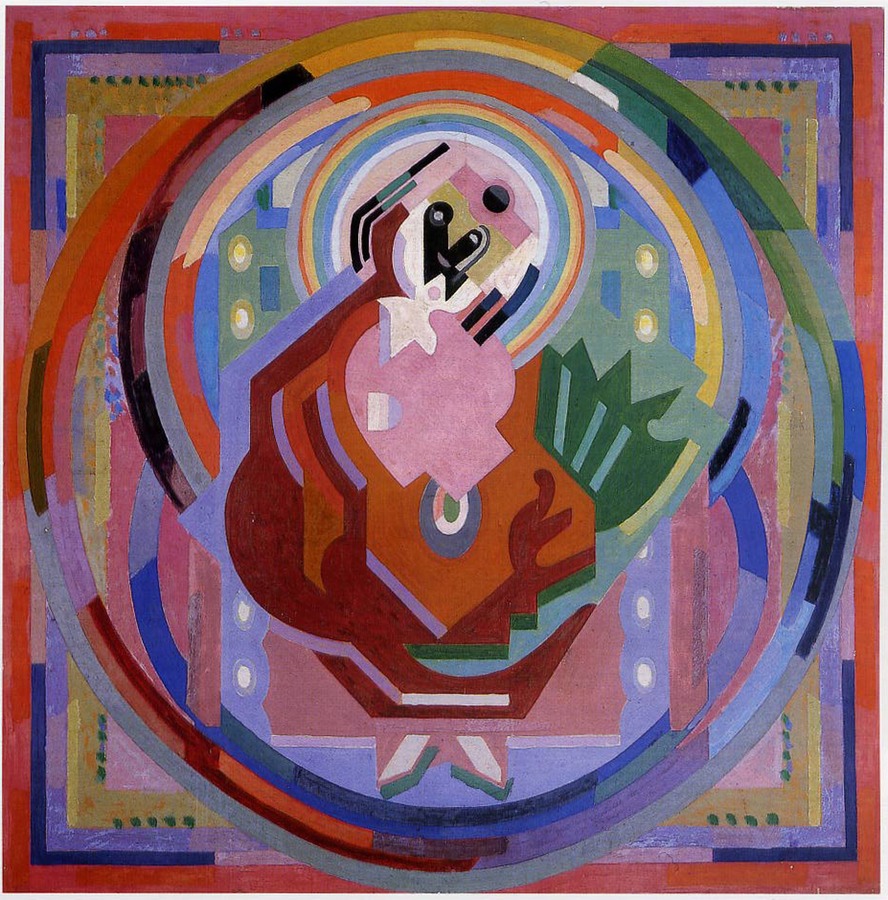THREE STAGES
Three stages, therefore, if the living experiment (which is to say, a human act guided by reason) that is mural painting is to succeed, if colour is once again to be joined to light:
A) First, the stage of organisation at the bodily level of the senses. The figures, coloured, combined together, arranged harmoniously in, for the figures, a game of proportions and, for the colours, of colour-harmonies. Nonetheless, figures and colours are inseparable, as that which contains and that which is contained. Domination of the straight line. Magnitudes modified by TRANSLATION. Everything is subject to measure.
B) Next the stage of movement, a series of undulations that can be seized at the level of the memory.
Since the centre of the wall is occupied with the theme that is there to satisfy the senses, it is round about this theme, in a rotating succession, through a series of concentric circles, that the interweaving of the movement of the colours will be established. In such a system, the resonances given by the central theme take off after the manner of a fugue or a counterpoint, developing a given melody. The successive series, interlacings, combinations, values will unfold logically, by the mere fact that this level represents the unbodied nature of TIME at an intensity of colour that is less strong than that of the arrangement given for the gratification of the senses, which is where all the most dramatic effects are concentrated. Here, on the level of the memory, it is the principle of cadence that is in charge.
C) Finally, a circle, wrapped round all the interweaving, all the interpenetrating, combinations which the rainbow has inspired. This circle will be reserved for the ‘grey’ which gives to the whole its intensity of light and on which, each of the colours employed resounds. The level of light is attained, the perfection of the rhythm.

Gleizes: Terre et Ciel, c1935
Oil on canvas, 136 x 136 cm
Musée des Beaux-Arts, Lyon
(One of the great paintings of the twentieth century)
For more on the 'three stages' see Albert Gleizes in 1934, elsewhere on this website, especially the 'analysis of mural painting' accessible here
These principles were known and applied throughout the Christian Middle Ages. Because the Christian Middle Ages were religious. And because they were religious, they were homocentrist. These principles allow man to realise a work on the basis of his own centre; and that is how all religious expression proceeds, independently of its iconography, which is only valid if it is expressed according to these principles Religious expression is, first and foremost, an ACT, and so it is itself, at one and the same time, its subject and its object. It accomplishes a mystery through the total realisation of the man who engages in it. Its subject and its object is man, freeing himself from his senses by means of his senses and from his memory by means of his memory, in order to arrive at his true FORM. In other words, through wall painting, man as colour, through the intermediation of the chromatic circle, can arrive at the realisation of man as light. Thus, a religious expression, by its nature as much as by its etymological definition, is directly related [reliée] to the men who contemplate it; whose reason dominates over their sensation; who know that their soul has for faculties understanding, will and memory; who wish to accomplish their own ascension and who are persuaded that it is by renouncing successively what at first appeared to them to be real, through the senses, through the memory, that, finally, they will come to their highest level, to their transcendent reality, in the light of the creation as it came from the hands of God. This light-creation is something other than the opaque universe which is the subject of the analytical studies of the scientists and which, whatever anyone may say or do, is not the Creation of the Creator.
The earthly painter puts himself at the centre of his work. From there he expands to the extreme limits of the reality that is accessible to his senses; and it is this that enables him to enter into the circle of his memory. It is the same when the work is contemplated by one of the faithful. He too places himself in relation to its axis. In this respect it is not necessary for the relations that have been established between the figures to evoke any picturesque reminiscences of the external world so long as there is a genuine harmony mastering the geometrical organisation of the elements. Then the believer will feel perfectly at ease, his curiosity will be awakened, and the desire to go further will be stimulated. Since the painter has submitted himself to the principles of homocentrism, the person contemplating the work will do the same.